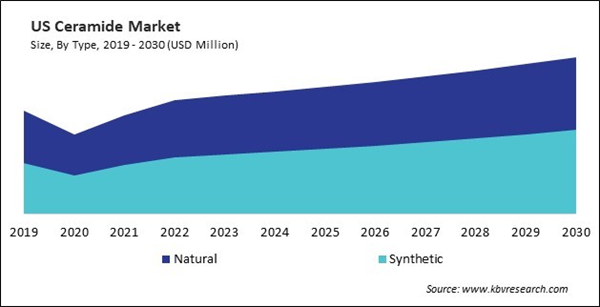Cosmetics infused with ceramides have become popular in the skincare industry due to their ability to address various skin concerns effectively. Ceramides, being natural components of the skin's outermost layer, play a crucial role in maintaining skin hydration and integrity. In cosmetics, it is incorporated into formulations such as moisturizers, serums, creams, and masks to enhance the skin's barrier function, improve moisture retention, and promote overall skin health. Therefore, the US market consumed 52.63 tonnes of Ceramide in Cosmetics in 2022.
The US market dominated the North America Ceramide Market, By Country in 2022, and would continue to be a dominant market till 2030; thereby, achieving a market value of $26,261.2 Thousands by 2030. The Canada market is experiencing a CAGR of 7.5% during (2023 - 2030). Additionally, The Mexico market would exhibit a CAGR of 6.6% during (2023 - 2030).
With the rise of personalized skincare regimens fueled by advancements in digital technology and data analytics, there is a growing demand for its products tailored to individual skin types, concerns, and lifestyles. Companies are leveraging AI-driven algorithms, skin analysis tools, and DNA testing to formulate bespoke skincare solutions that optimize delivery and efficacy for each consumer.
Moreover, these are critical in maintaining skin barrier integrity, hydration, and overall health. Due to their versatility and compatibility with various skin types and conditions, the products are well-suited for personalized skincare formulations. By integrating ceramides into customized skincare regimens, organizations can promote skin health and resilience while addressing particular skin issues, including dehydration, sensitivity, aging, and inflammatory conditions.
The Canadian cosmetics industry is known for its innovation in product formulations. Cosmetic companies in Canada often invest in research and development to create high-quality, effective skincare products. As per the data provided by the International Trade Administration in 2021, the cosmetics sector in Canada generated approximately USD 1.24 billion in revenue. Industry revenue is expected to reach USD 1.8 billion by 2024. Hence, North America’s rising cosmetics and pharmaceutical sectors can lead to an increased demand for ceramides.
Based on Application, the market is segmented into Cosmetics, Food, and Others. Based on Process, the market is segmented into Plant Extract, and Fermentation. Based on Type, the market is segmented into Natural, and Synthetic. Based on countries, the market is segmented into U.S., Mexico, Canada, and Rest of North America.
List of Key Companies Profiled
- Ashland Inc.
- Toyobo Co., Ltd.
- Doosan Corporation
- Arkema S.A.
- Evonik Industries AG (RAG-Stiftung)
- Cayman Chemical Company, Inc.
- Kao Corporation
- Croda International PLC
- Vantage Specialty Chemicals (H.I.G. Capital, LLC)
- Incospam Co., Ltd.
Market Report Segmentation
By Application (Volume, Tonnes, USD Million, 2019-2030)- Cosmetics
- Food
- Others
- Plant Extract
- Fermentation
- Natural
- Synthetic
- US
- Canada
- Mexico
- Rest of North America
Table of Contents
Companies Mentioned
- Ashland Inc.
- Toyobo Co., Ltd.
- Doosan Corporation
- Arkema S.A.
- Evonik Industries AG (RAG-Stiftung)
- Cayman Chemical Company, Inc.
- Kao Corporation
- Croda International PLC
- Vantage Specialty Chemicals (H.I.G. Capital, LLC)
- Incospam Co., Ltd.









